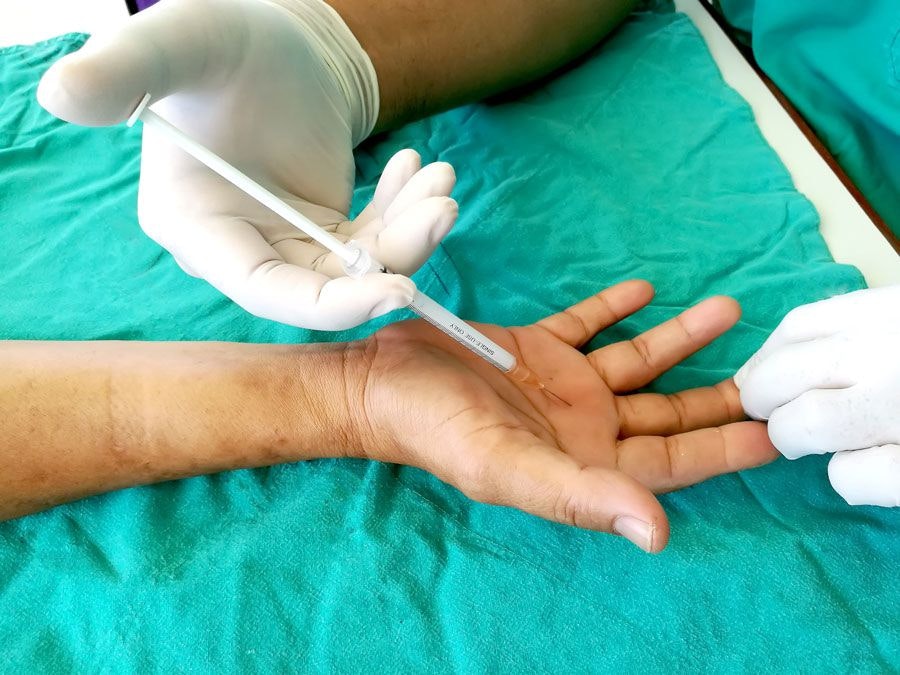
Trigger Finger
Why Is It Called "Trigger Finger?"
/
A finger with this condition can make a clicking sound when it is straightened or bent. The sound is similar to the "click" made when the trigger of a gun is pulled.
I Hear a Click When I Bend My Thumb Are There Other Trigger Finger Symptoms I Should Know About?
Contact Dr. Vagner immediately if you experiencing any of these symptoms. They can occur in any finger but are mainly experienced in the thumb, middle, and ring fingers. A thorough examination at our Austin or Cedar Park, TX, offices can determine if you have trigger finger. You may notice that these symptoms may be worse in the morning or when you haven't moved your fingers or thumb in a while.
- Inability or difficulty straightening a finger from its bent position
- Burning joint pain when your finger goes into a straightened or bent position
- A popping sensation when you straighten a finger
- A sensitive bump, or nodule, at the base of the affected finger
- Finger numbness and/or stiffness
Don't Let Trigger Finger
Symptoms Affect Your Life
Contact Our Double-Board Certified Orthopedic Surgeon Today
Unlike many other orthopedic surgeons, Dr. Vagner focuses on hand, wrist, and elbow issues. This means he concentrates only on treating these specific areas of the body at his Austin and Cedar Park, TX, locations.
If you have trigger finger, shouldn't you see a doctor who specializes in hand conditions?
Dr. Vagner is the best surgeon to diagnose and treat your trigger finger symptoms in the Austin, TX, area. Simply use our online form or call to request your trigger finger consultation. We have three high-tech offices in Austin and one in Cedar Park for your convenience.
(512) 454-4561
We Appreciate Our Patients' Kind Words
Dr. Vagner is a very knowledgeable, personable, and caring professional who explains the medical issue, treatment options, and patient-approved treatment plan clearly, thoroughly, and respectfully. I would definitely see him again should the need arise.
Read Google ReviewsNot only do Doctors save people, they also save people from killing themselves. Well done St. Davids staff. Plus they seemed genuinely glad to be there. Also, they treated my partner and my service dog with respect and love.
Read Google ReviewsMain Causes of Trigger Finger
Inflammation
Tendons are cords of elastic collagen tissue that connect your muscles to your bones. Flexor tendons run down from the muscles in your wrist, along your palm, and to your fingers. These tendons pass through a tunnel of protective tissues called the tendon sheath. Trigger finger occurs when the tendon sheath is inflamed due to repetitive motion, rheumatoid arthritis, or a hand injury. When the sheath becomes swollen (called tenosynovitis), tendon movement becomes limited. Over time, continual irritation may cause nodules to form, further affecting finger motions.
Repetitive Motions
Trigger finger, or stenosing tenosynovitis, often develops because of hand motions repeated over long periods of time, which inflames the sheath around the tendons. Therefore, you are at a higher risk of developing trigger finger if you tend to make the same movements repeatedly because of your job or a hobby. For example, musicians, farmers, dental technicians, and cashiers are at a higher risk of developing trigger finger. Repetitive motions can include texting, typing, playing a musical instrument, or grasping heavy objects.
Activities Like These Can "Trigger" Trigger Finger

Who Is at Risk Of Developing Trigger Finger?
Women are more likely to develop trigger finger than men.
Hypothyroidism, rheumatoid arthritis, and tuberculosis can also increase your risk.
People between the ages of 40 and 60 are more likely to develop trigger finger.
Alleviating Trigger Finger at Home
If you're beginning to notice the onset of trigger finger symptoms, there are some ways you can alleviate them, such as:
- Apply heating pads or cold packs to the affected finger and hand
- Take over-the-counter NSAIDs to reduce pain and inflammation
- Apply topical NSAIDs to the affected area to alleviate pain and inflammation
- Perform a self-massage to the affected area
- Rest the affected finger for one to two weeks
- Wear a splint while you sleep to keep the finger in a straight position
- Exercise the hand and finger to stretch and strengthen the muscles
- Use adaptive tools to lessen the effects of friction that can strain your fingers
Even when using these at-home practices, seeking out treatment with Dr. Vagner in Austin or Cedar Park can provide you with more permanent solutions. He can explain how these at-home solutions can be used in combination with in-office treatment.
Treating Your Trigger Finger When At-Home Care Isn't Enough
If you've tried to alleviate the symptoms of your trigger finger at home with no success, it may be time to call our double board-certified orthopedic surgeon.
Dr. Vagner can provide you with a variety of solutions and help you develop a more long-lasting treatment plan so you can live your life comfortably and perform your hobbies and work without the hindrance of trigger finger.
Request a consultation with our orthopedic surgeon by filling out our contact form or by calling one of our offices serving the Austin area and beyond:
(512) 454-4561

Request a Consultation Today
High Praise for Dr. Vagner
Dr. Vagner is the best doctor! We have seen him for my son's broken arm. He took care of him, was so friendly and great to deal with. His staff was nice and friendly also. When my son sprained his ankle, I didn't know where to turn and contacted him. Even though this is not his specialty, HE took the time (like we were family) to refer us and asked many questions about my son's sprain. His referral, Dr. Ebert, was equally as qualified and we felt like we were given the best treatment we could have had!
Read More ReviewsVery Professional and Polite Surgeon. He was able to quickly meet us at Dell Childrens on a late Sunday afternoon after my son had a bad incident with a finger. While it looked really bad, he went to work quickly and managed to repair the damage and give my son access to his finger again. Hate to be in a situation like this, but so very happy that Dr Vagner was able to calmly guide us out of trouble.
Read More ReviewsRestoring Finger Dexterity

Dr. Vagner's Trigger Finger Treatments
Cortisone
Dr. Vagner usually first tries treating trigger finger with cortisone injections. This medication can reduce inflammation within the finger. Most patients regain normal finger movement after one or two injections into the tendon sheath.
Surgery
Dr. Vagner may suggest surgery if injections or other non-surgical treatments prove insufficient. This outpatient procedure is done under local anesthesia, with full recovery only taking a week or two.
What Does Trigger Finger
Surgery Involve?
After numbing your hand, Dr. Vagner will make a very small incision in the sheath that contains your finger's tendons. This is done to allow the flexor tendon to move more freely.
You will need to wear dressings for about two days. Stitches can be removed in about 10 days.
Your hand movements and ability to lift heavy objects may be limited for around two weeks. You can reduce pain and swelling during this time by elevating your hand above your heart. Though you may recover from your surgery in a few weeks, you may experience swelling and stiffness for up to six months. After your recovery, you should have greater dexterity and a much-improved quality of life.
Preventing Trigger Finger
Avoid Certain Activities
You can reduce the risk of acquiring trigger finger by avoiding activities that put repetitive strain on the tendons of your palms. These include excessive computer and mobile phone use.
Stretch Regularly
Gentle exercises can help maintain healthy mobility, reduce discomfort, and keep circulation flowing. Dr. Vagner can recommend effective exercises. Doing these simple stretches can prevent the onset of trigger finger.
What to Expect During Your Trigger Finger Evaluation

Dr. Vagner can diagnose trigger finger with a state-of-the-art clinical exam at his Cedar Park and Austin, TX, offices. He will review your symptoms with you and closely examine your hand to determine if trigger finger is to blame for your discomfort.
In addition to your hand examination, Dr. Vagner may inquire about:
- The length of your symptoms
- Anything that worsens your symptoms
- A time of day when your symptoms are worse
- Your job and hobbies
- Any injuries you may have sustained
Trigger Finger Treatment Cost
Contact our practice to learn more about the exact cost of trigger finger treatment. Dr. Vagner accepts insurance and offers various payment plans to make out-of-pocket costs more manageable. He wants all his patients to get the relief from trigger finger that they need, regardless of financial issues.
Understanding the Risks of Hand Surgery
Like any surgical procedure, surgery for the treatment of trigger finger may result in complications. However, by choosing a double-board certified orthopedic surgeon like Dr. Vagner you can lower your chances of experiencing complications, such as:
- Infection
- Finger pain, tenderness, and stiffness
- Scarring
- Nerve damage
- Bowstringing (a tendon in the wrong position)
More About Gregg Vagner, M.D.
Dr. Vagner is a double board-certified orthopedic and hand surgeon who combines the latest research and techniques to treat the hands, wrists, and elbows. His accolades and roles in his field include:
- Distinguished Surgeon of the Year Award - Austin Area Association of Perioperative Medicine
- Clinical Assistant Professor of Surgery in Perioperative Care - Dell Medical School
- Hand Surgery Consultant - University of Texas Athletic Department

Can Trigger Finger Heal on Its Own?
There is a possibility that your trigger finger could heal on its own or with simple at-home remedies if you have a mild case. However, if you don't see any improvement with at-home treatment or you're worried your condition may get worse, consult with our orthopedic surgeon to aid in your recovery.
"I've seen him twice, once for suspected carpal tunnel problem and a trigger finger. In both cases he suggested splinting them first. That worked, so no surgery necessary. I'll be seeing him soon for a sore thumb joint. I'm sure I'll be in good hands (pun intended)..." Bette Pritchett, 5-Star Reviews

